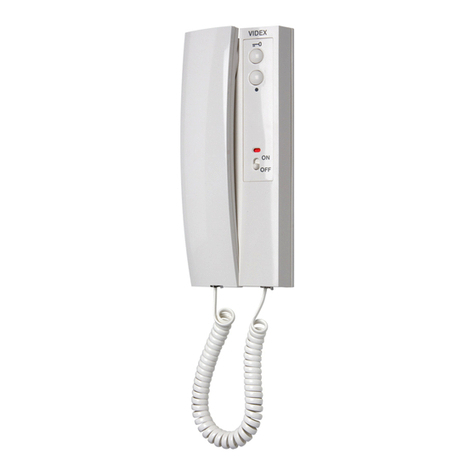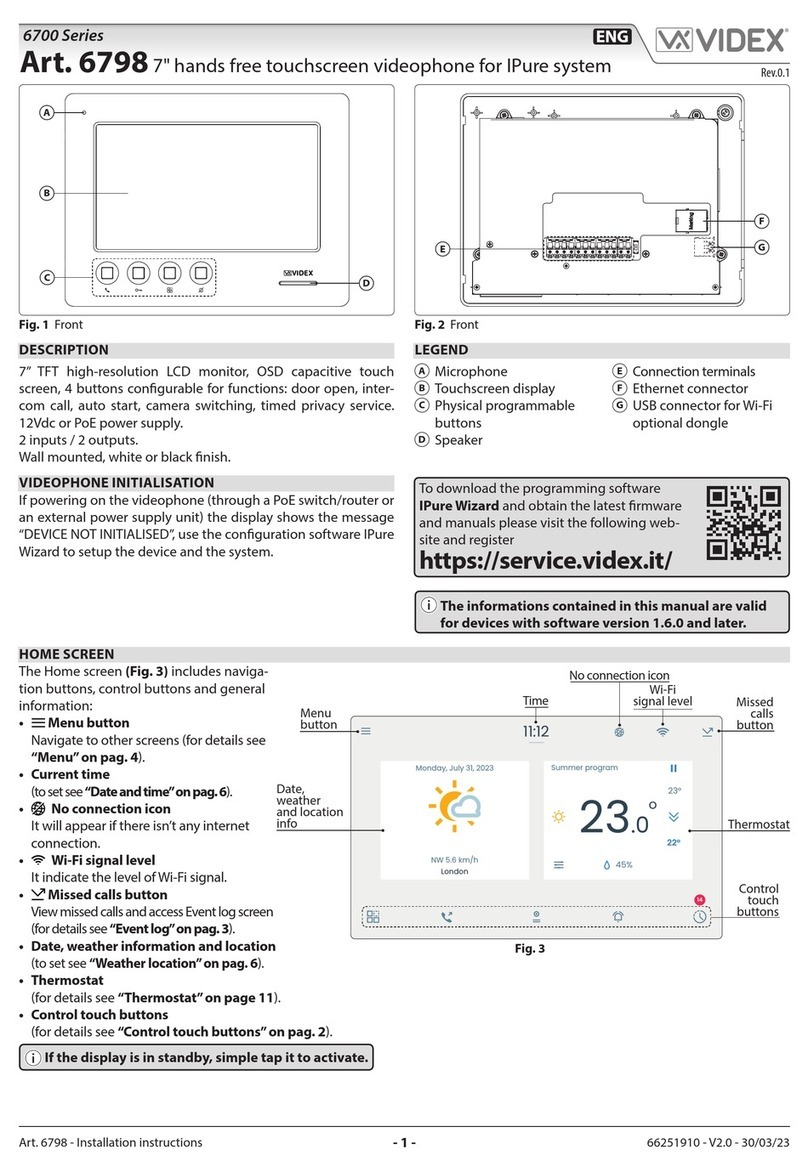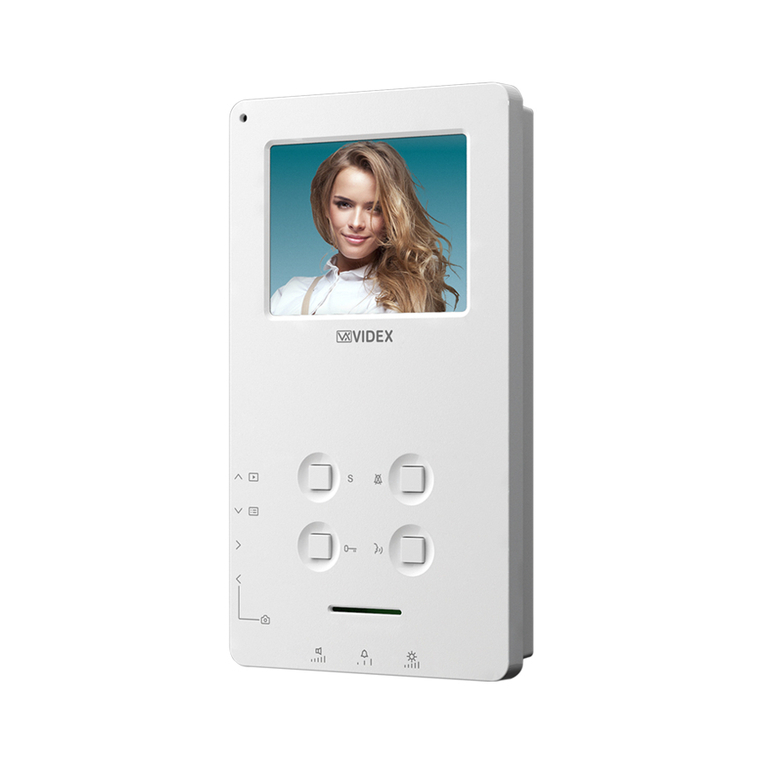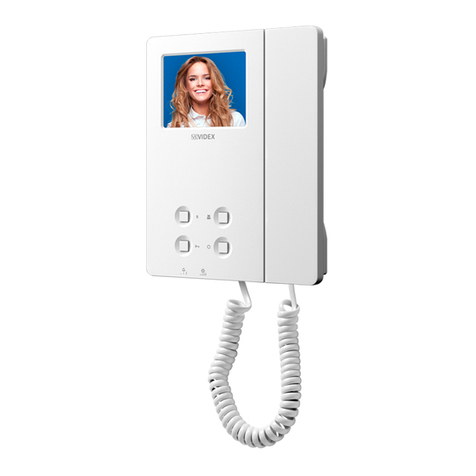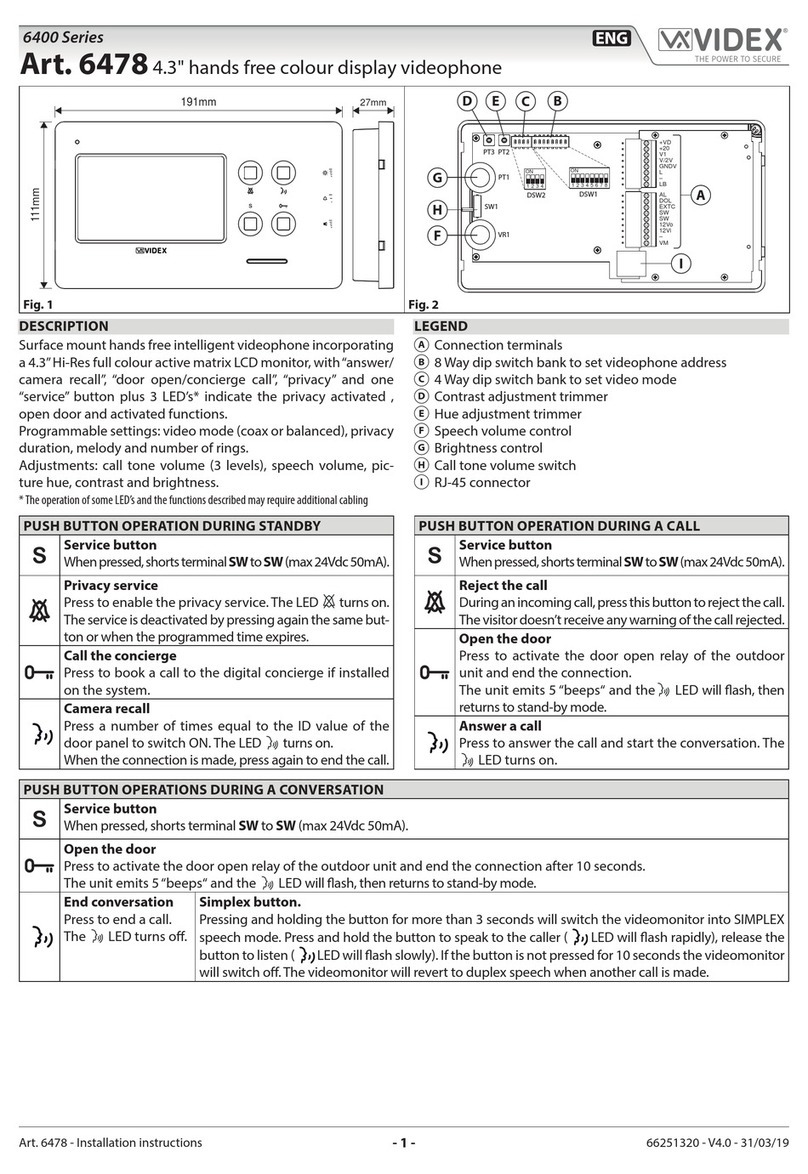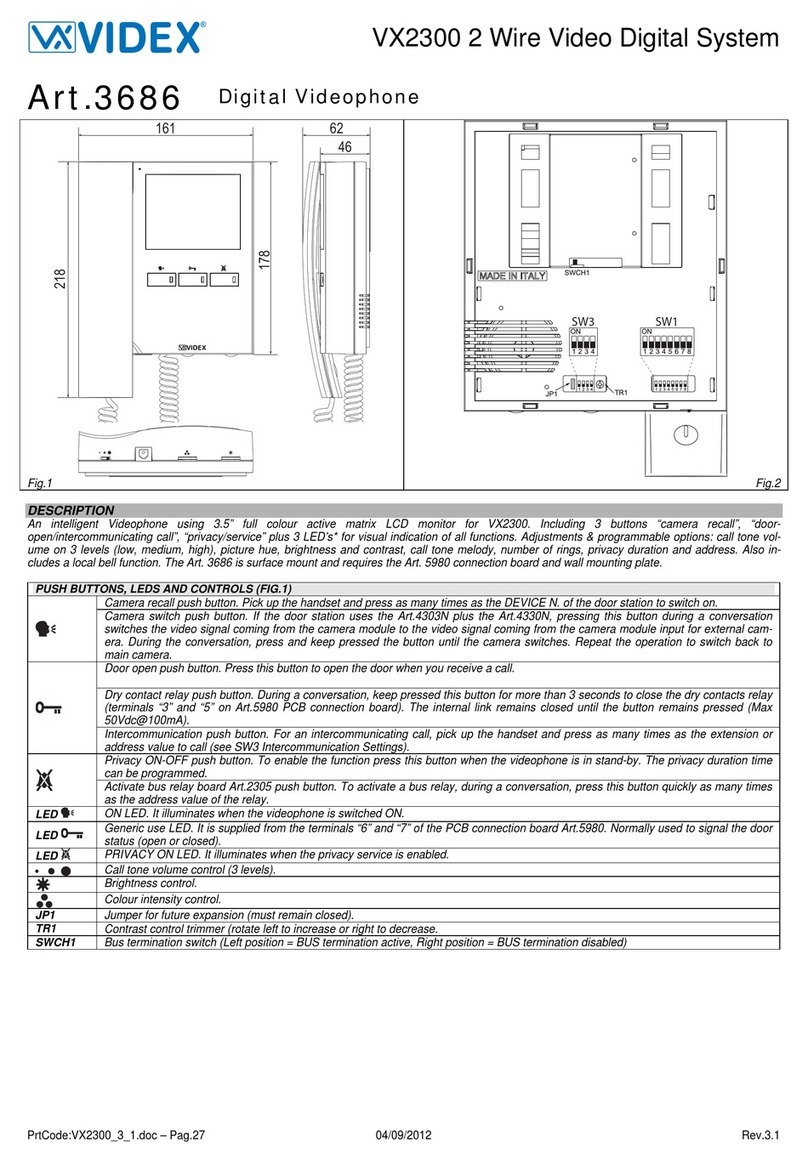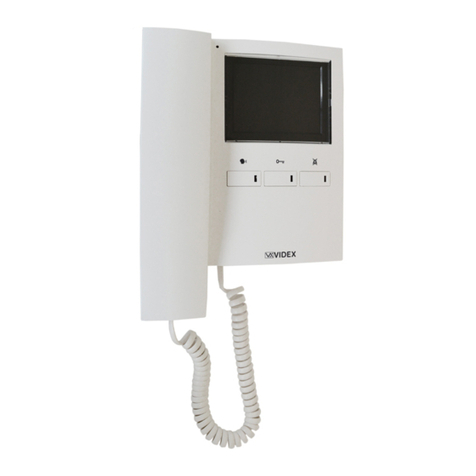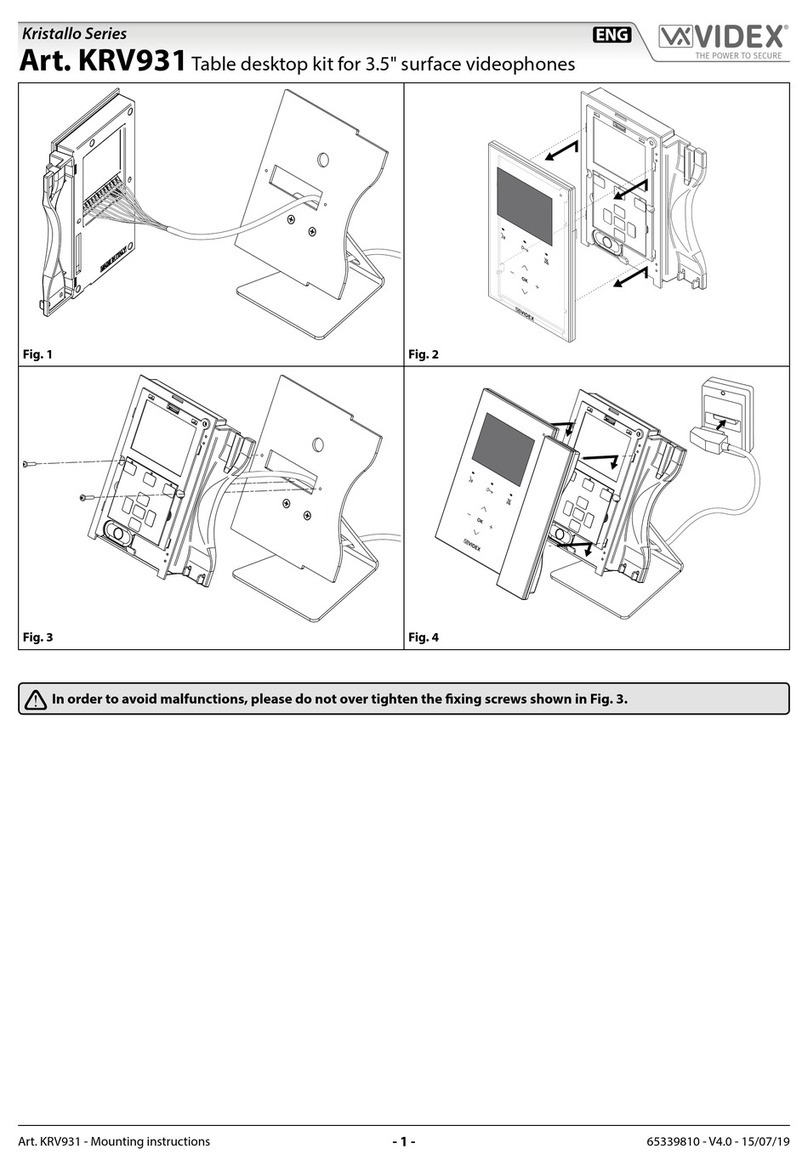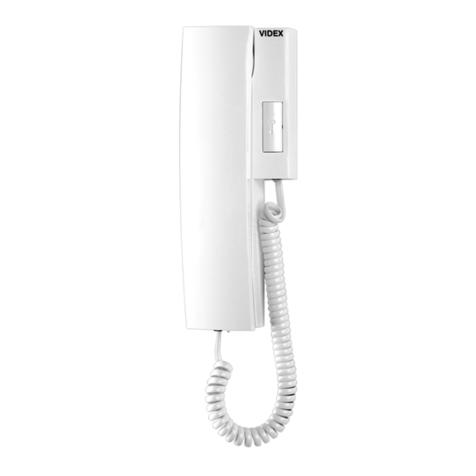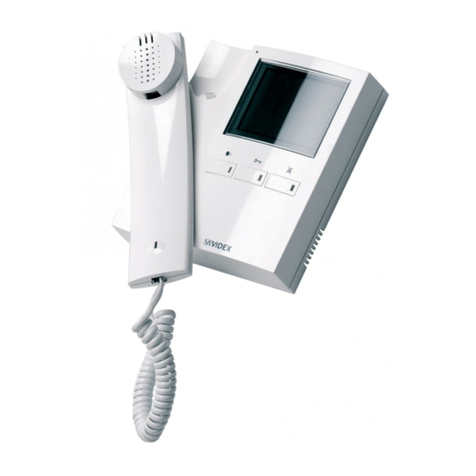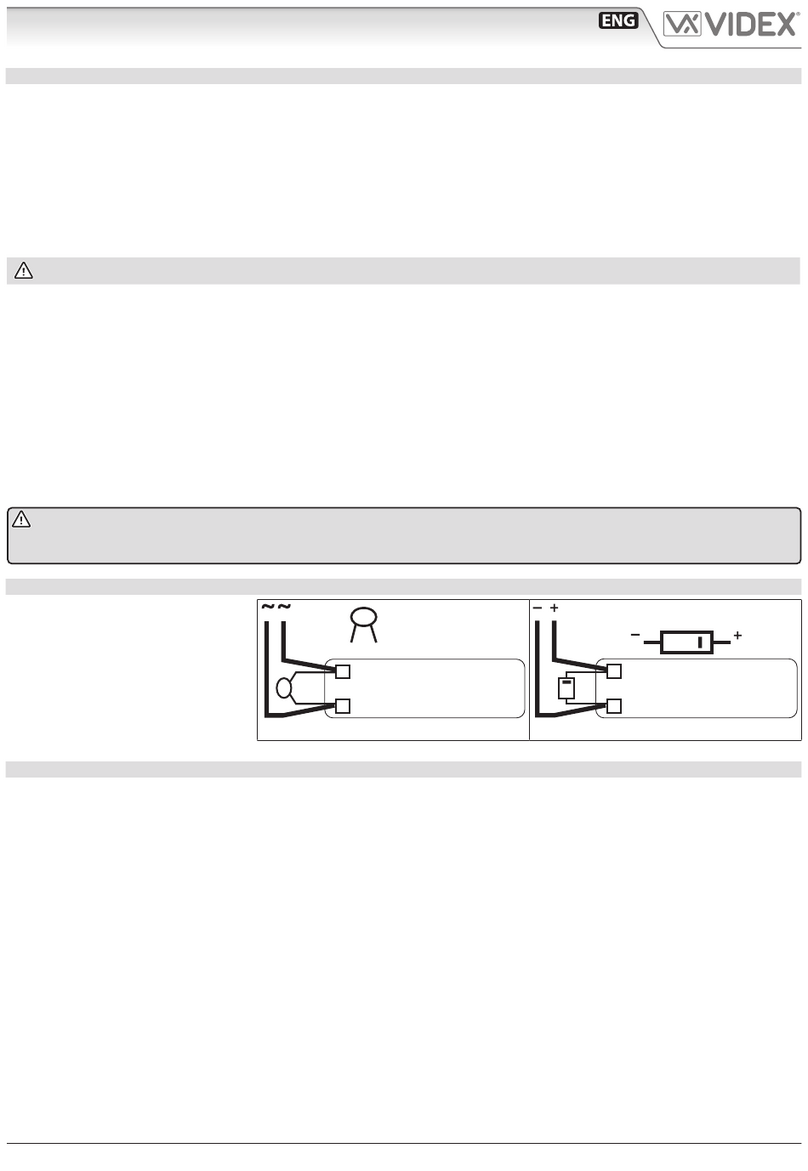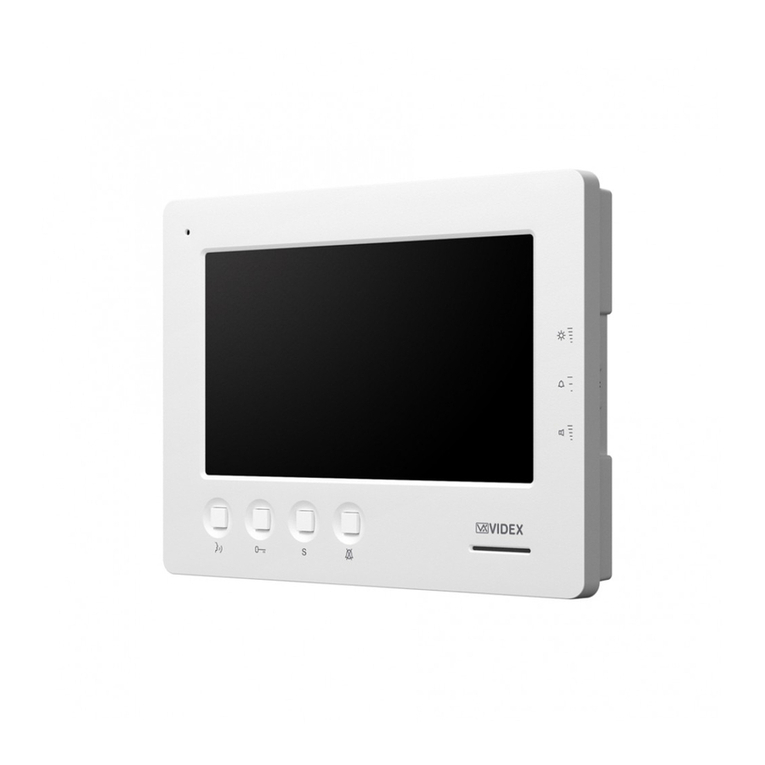!
!
!
!
!
!
!
!
C
C
C
Svitare la vite alla base della placca frontale impiegando un cacciavite a
croce,
Rimuovere la placca frontale facendole prima compiere un leggero
movimento indietro (3-4mm) e quindi sollevandola nella parte inferiore
come mostrato rispettivamente nelle figure 2 e 3.
Rimuovere il supporto per lo speaker (lasciando lo speaker inserito)
tirandolo leggermente verso l’alto come mostrato in figura 4, fino a
raggiungere la condizione di figura 5 (supporto sganciato e rivolto verso il
basso).
Prendere i riferimenti per i fori di fissaggio e per il passaggio dei fili (Rif.H
figura 5), posizionando il posto esterno alle quote mostrate in figura 6
(165-170cm dalla parte superiore del posto esterno al terreno). Qualora i
fili fossero già passati, prendere i riferimenti per i fori di fissaggio tenendo
presente che i conduttori dovranno fuoriuscire dall’apposita fessura del
posto esterno
come mostrato in figura 1.
(Rif.H figura 5). Per collegare agevolmente i conduttori, si
raccomanda di lasciare una lunghezza di 5cm a partire da filo muro (vedi
figura 7).
Eseguire i 4 fori di fissaggio dal diametro di 6mm (Rif.A figura 7); inserire
nei fori i 4 tasselli ad espansione forniti a corredo (Rif.B figura 7);
ricordando di far passare i conduttori attraverso l’apposita fessura (Rif.H
figura 5) del posto esterno, appoggiare l’unità (Rif.C figura 7) al muro e
fissarla con le 4 viti (Rif.D figura 7) fornite a corredo, tramite un cacciavite
a croce.
Fissato a parete il posto esterno, procedere alla realizzazione dei
collegamenti inserendo i conduttori (Rif.E figura 8) nelle apposite
morsettiere (Riff.F e G figura 8). Si ricorda che i collegamenti dovranno
essere eseguiti in base agli schemi di installazione forniti a corredo.
Serrare i conduttori all’interno dei morsetti utilizzando un cacciavite a
taglio. Per l’operazione di inserimento dei fili all’interno dei morsetti si
consiglia l’utilizzo di apposite pinzette (Figura 8).
Eseguiti i collegamenti, ricollocare il supporto per lo speaker nel suo
alloggiamento (condizione di figura 4), quindi procedere al collaudo
dell’impianto ed alla regolazione del brandeggio della telecamera. Per
regolare il brandeggio muovere delicatamente la telecamera secondo le
direzioni mostrate in figura 8 (Rif.J).
Terminato il collaudo, chiudere il posto esterno fissando la placca frontale.
Per fissare la placca frontale:
posizionarla come mostrato in figura 3 (lasciando circa 3-4mm tra la
parte superiore della placca e la superficie di contatto con la base
porta componenti) e successivamente avvicinarla completamente
alla base compiendo un movimento in senso contrario a quello della
freccia di figura 3;
spingere la placca leggermente verso l’alto, compiendo un
movimento in senso contrario a quello della freccia di figura 2, fino a
portarne la parte superiore a contatto con la base porta componenti;
avvitare la vite alla base della placca frontale ruotando il cacciavite in
senso inverso a quello della freccia di figura 1.
I videokit SMVK1 sono forniti con i videocitofoni della
serie 3000 ed il posto esterno Art.331K. Quest’ultimo ha
subito degli aggiornamenti
nel design, nell’elettronica e nella meccanica
che gli hanno conferito una maggiore resistenza agli
agenti atmosferici. Anche il meccanismo di brandeggio
della telecamera è stato modificato aumentandone
l’angolo di escursione (10 Gradi) e la possibilità di
movimento sia in senso verticale che orizzontale; questo
consente di regolare una buona inquadratura anche
quando il posto esterno deve essere installato in punti
critici (zone esposte al sole, nascoste ecc.).
Il kit (monofamiliare) è composto da:
Nr.1 - Unità di ripresa. Incorpora una
telecamera CCD auto focus di alta qualità completa
di LED per l’illuminazione agli infrarossi (nella
versione colori i lED sono ad emissione di luce bianca); la circuiteria di
amplificazione audio ed il portiere elettrico (dimensioni del posto esterno
come da disegno - quote in mm).
Nr.1 - Videocitofono Bianco & Nero con schermo piatto da 4”.
Nr.1 - Trasformatore di alimentazione in contenitore DIN 5
moduli - tipoA. Primario 127-230Vac, Secondario 24Vac-1,6A.
La versione a colori prevede l’unità di ripresa al
posto della ed il videocitofono a colori con schermo piatto TFT
, al posto del . La placca frontale del posto esterno è
disponibile in 2 finiture: Bianco e Grigio (/W o /G dopo il codice).
(rispetto ai precedenti posti
esterni)
La versione con memoria video prevede l’
(videocitofono Bianco & Nero con schermo piatto da 4” e memory board) al
posto del e l’ (alimentatore in contenitore DIN 8 moduli -
tipo A con doppia tensione di uscita 24Vac 1,6A e 12Vdc 0,2A per
l’alimentazione della memory board) al posto dell’ .
SMVK1
Art.331K
Art.3351
Art.850K
CSMVK1 Art.331KColour
331K
Art.3451 3351
-
-
-
SMVK1/MV Art.3551
3351 Art.850K/MV
850K
2
SMVK1, SMVK1/MV, CSMVK1 Easy Videokit B&W, con MEMORIA VIDEO, a COLORI
SMVK1, SMVK1/MV, CSMVK1 Easy Videokit B&W, with MEMORY BOARD, COLOUR
ISTRUZIONI PER L’INSTALLAZIONE DEL POSTO ESTERNO
MOUNTING INSTRUCTIONS OF THE OUTDOOR STATION
The new videokit SMVK1 is supplied with the 3000 series
videophone and the new more compact outdoor station
Art.331K. The new outdoor station (Surface mount only)
has been improved in a number of ways for better
endurance to the weather. The mechanism to adjust the
viewing angle has been changed to allow a larger angle
(10 Degree) than before and to allow horizontal and
vertical motion of the camera; This enable an adjustment
to the picture when the outdoor station is installed in
critical areas (areas exposed directly to the sun light,
hidden areas etc.).
The (one way videokit) is comprised of:
- Outdoor Station. It incorporates a
high quality auto iris lens CCD camera B&W, LEDs
for infrared illumination (white light LEDs for colour
version), audio amplifiers and one call button (outdoor station size as in
the drawing - unit mm).
- Videophone with a 4” B&W flat screen monitor.
- Power transformer in a type A 5 module DIN box;
primary: 127 and 230Vac, secondary 24Vac 1,6A.
SMVK1
Nr.1 Art.331K
Nr.1 Art.3351
Nr.1 Art.850K
-
-
-
The uses the (a videophone with a 4” flat screen
monitor B&W plus the memory board) instead of the Art.3351 and the
(Power Supply in a type A 8 module DIN box with 2 output
voltages: 24Vac 1,6A and 12Vdc 0,2A for memory board supply) instead of
the Art.850K.
The uses the (a videophone with a colour 4” TFT flat
monitor) instead of the and the colour outdoor station
instead of the .
The front plate is available in two different finishes: white and grey (put /W or
/G after the product code).
SMVK1/MV Art.3551
Art.850K/MV
CSMVK1 Art.3451
Art.3351
Art.331KColour Art.331K
!
!
!
!
!
!
!
!
C
C
C
Unscrew the screw at the bottom of the front plate using a Phillips
screwdriver as shown on figure 1.
Gently slide the front plate down (3-4mm) and then raise it at the bottom as
shown on figures 2 and 3.
Extract the speaker housing (leaving the speaker inside it) lifting it up
gently as shown on figure 4 until the speaker housing is as shown in figure
5 (speaker bracket down).
Place the outdoor station against the wall (165-170 Cm between the top of
the outdoor station and the floor level as shown on figure 6) and mark the
fixing holes (Ref.A figure 7) for the four wall plugs (Reff.B figure 7) and the
hole for the cables with reference to the relevant opening on the outdoor
station (Ref.H figure 5). For ease of connection, the cables should be at
least 5 cm in length from the wall (see figure 7). If the cables are placed,
mark the holes feeding the wires through the outdoor station opening
(Ref.H figure 5).
Make the four fixing holes (Ref.A figure 7 - 6mm n); put inside the holes
the four wall plugs provided (Ref.B figure 7);place the outdoor station
against the wall feeding the cables through relevant opening (Ref.H figure
5) and then fix it to the wall with the four screws provided using a Phillips
screwdriver.
After the outdoor station is fixed to the wall, make the connections by
putting the cables (Refer figure 8) into the relevant terminals (Refs. F and
G figure 8). The connections must be made as per the installation diagram
provided. Fix the wires inside the terminals using a terminal screwdriver.
For ease of connection we suggest using tweezers to locate the cables
into the terminals (see figure 8).
After the system test, Refit the outdoor station front plate. Fix the front
plate as follows
Place the front plate over the outdoor station as shown on figure 3
(leaving 3-4mm between the top of the plate and the outdoor station)
then move the bottom of the plate in the opposite direct to the arrow
in figure 3 bring the plate towards the back box.
Slide the plate upwards in the opposite direction to figure 2.
Fix the plate using the relevant screw.
After the connections are made, put the speaker back with its bracket (it
should go back as shown on figure 4) then test the system and adjust the
viewing angle moving the camera slightly to the direction required (Ref. J
figure 8).
